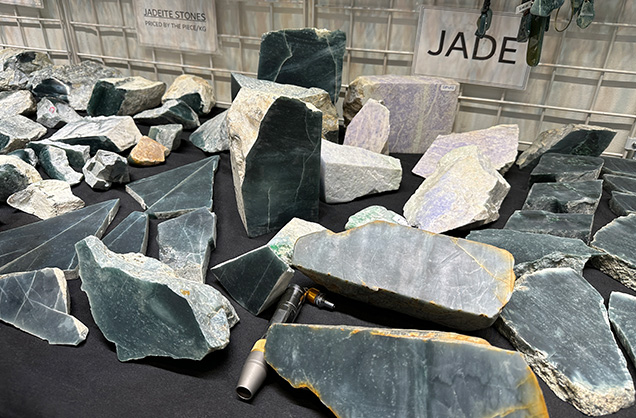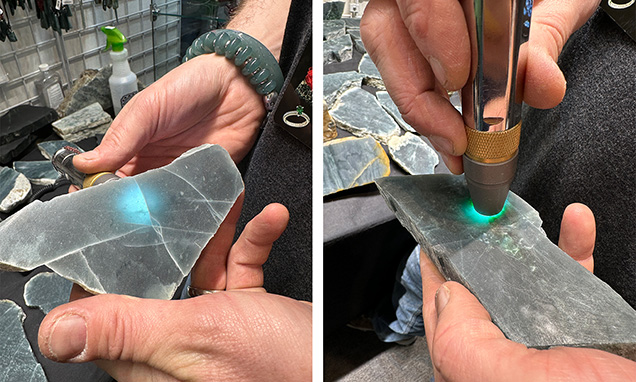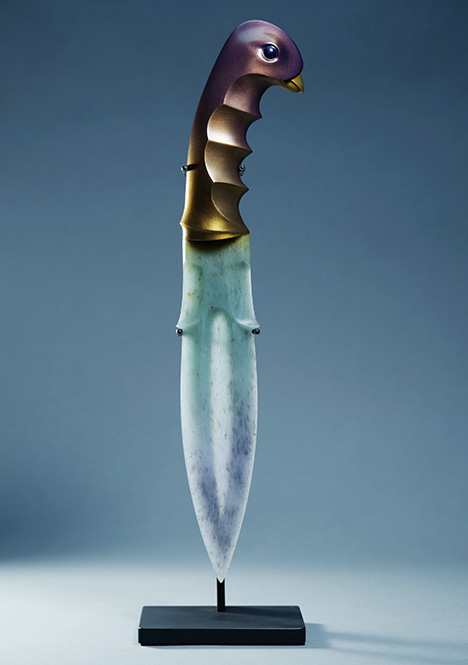Guatemalan Jadeite Jade: Rough and Finished

Jadeite jade is one of the most important aggregate gems in today’s global marketplace, with known sources in Myanmar, Japan, Russia, and Guatemala. Among them, Myanmar is the most legendary and still dominates today’s market. Guatemala, however, has recently reclaimed its status as an important jadeite jade producer (see Z. Huang et al., “‘Ice jade’ from Guatemala,” pp. 26–41 of this issue).
At this year’s 22nd Street show, Yax Tun Minerals (Denver, Colorado) offered a wide range of Guatemalan jadeite jade, including rough pieces in blue, green, and lavender (figure 1). According to owner Luke Miller, the bluish color is the most common and the most desired in the American market. All rough is covered with a “skin” resulting from weathering.

The seller provided a strong flashlight for buyers to assess the quality of the rough, similar to what buyers do at the major jadeite auction in Myanmar. The blue color was quite saturated, while the green and lavender colors were not. The bluish rough showed high transparency and some had green veins running through it (figure 2, left). The green veins also exhibited high transparency (figure 2, right). The lavender rough pieces were of low transparency and had a coarser texture than the other two color varieties (figure 1).
The blue color is characteristic of Guatemalan jadeite jade, which is often called “Olmec blue” in the trade. The Olmec civilization was a Mesoamerican culture revealed by archaeological artifacts. The blue to green-blue jadeite jade mined in Guatemala was prized by the Olmecs from about 1500 to 400 BCE. Mesoamerican cultures that followed, such as Mayan, Zapotec, and Totonac, continued the reverence for jadeite jade. But when the Spanish conquered Mesoamerica in the sixteenth century, their appetite for gold and emeralds contributed to the fall of Guatemalan jadeite jade popularity. Mayan guards kept the jade mine locations secret, and they were not rediscovered until 1974. Since then, Guatemala has been gradually regaining recognition as an important source of jadeite jade.
Finished products offered at the Yax Tun booth included beads, beaded necklaces, bracelets, earrings, and small pendants, polished or carved. Many of the top-quality materials are processed at Miller’s carving studio in Mexico.

As Guatemalan jadeite jade gains popularity among both Western and Asian consumers, more gem artists are using this material to show their creativity. World-renowned sculptor Georg Schmerholz brought an outstanding collection of jade to the Tucson Gem and Mineral Show. His latest creation, “Rainbow Luna,” is second in the “Resplendent Quetzal” series, which honors a beautiful bird native to Guatemala. Completed in June 2023, the 14-inch dagger is carved from the finest Guatemalan jadeite jade with a patinated bronze handle (figure 3). Schmerholz’s jade art bridges the two disciplines of sculpture and gemstone carving.
The wide range of appearance and quality of Guatemalan jadeite jade offers versatility to designers, artists, and consumers. Sufficient production and distribution are essential for this gem material to reach a wider audience.



